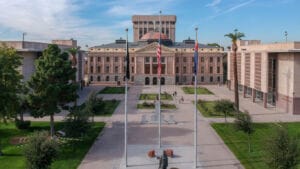As Arizona emerges from a grueling global recession, business and civic leaders are focusing on creating jobs and jump-starting our economy. Valley Partnership, as the state’s only grass-roots organization devoted to promoting responsible development, is poised to play an important role in that process.
“Our goal is to help stimulate the local economy by our actions,” says this year’s board chair Mindy Korth, an executive vice president and capital markets broker at CB Richard Ellis.
With its extensive ties throughout the development community, as well as into municipal and state offices, Korth says Valley Partnership is in a unique position to help get the economy moving again.
To say the past two years have been challenging for the commercial real estate industry would be an understatement.
Speculative construction in the office, industrial and retail sectors just about ground to a halt, with most construction occurring on build-to-suit projects or others already in the pipeline.
And as the Valley begins to see an uptick in business activity and employment, it is more crucial than ever that the principles of responsible development and job creation come to the forefront — something Valley Partnership has been promoting for 24 years.
As in the past, the linchpin of Valley Partnership’s efforts will be its advocacy, Korth says. Historically, the organization has been remarkably successful in rallying its partners — either against measures that would impose onerous restrictions on development, or on behalf of measures that would promote good growth.
“That’s an ongoing effort,” says Richard Hubbard, president and CEO of Valley Partnership. “We’ve always advocated against over-burdensome regulations at the local and state level.”
This year, Hubbard says Valley Partnership also will emphasize partner-to-partner relationships, as well as those between private and public entities.
Standing Apart
Valley Partnership’s more than 500 partners include representatives from all tiers of commercial real estate — from developers to attorneys to general contractors and engineers. Two important characteristics set it apart from other organizations: its relationships with public sector and government representatives and its emphasis on local stakeholders advocating on behalf of local issues.
“We are specific to the Valley,” says Rick Hearn, director of leasing for Vestar, one of Valley Partnership’s original corporate partners. Hearn has served on the board of directors for six years, and in that time has witnessed the organization’s partners tackle thorny local issues.
“We advocate on behalf of this industry better than anyone else,” he says, adding, “Not one of the national organizations comes close to touching the value proposition of what we do. We work at so many levels and have so many relationships.”
Not only does Valley Partnership share information and expertise with municipal and state leaders, it also has ties to federal officials and even someone at Luke Air Force Base.
City, state and federal partners can dip into Valley Partnership’s brain trust and glean important information on many pressing issues, Korth says.
For example, a municipality that is re-examining its city plan can garner feedback from Valley Partnership. The organization’s task forces dig deeper into issues, then forwards recommendations to a committee before the organization arrives at a public stance.
Some of the measures its committees are examining include:
- The Maricopa Association of Government’s efforts to design a dark-sky ordinance to reduce excessive light, while also addressing safety issues for tenants and customers.
- Maricopa County drainage permits and other building permit issues.
- Incorporating Green Building Codes within Valley cities’ building codes.
- Proposed city general plans.
Valley Partnership Value Proposition
Another important initiative this year is to make partners more aware of the value that Valley Partnership adds to their efforts. Korth says the communications committee is working hard to articulate back to all partners on what is being accomplished.
“We need to let them know that there is no one else like us here and if we did go away there’d be a gaping hole,” she says.
While membership did drop some during the recession, it is starting to tick back up, Hubbard says. As it does, Valley Partnership also is setting goals for its other key functions: education, networking and public service.
Hubbard said the organization surveyed its members to see what issues they would like to see addressed at educational events and Friday breakfast meetings, a staple for many partners.
Respondents said they would like to hear from industry leaders in the community and those involved in important development issues.
Signs are evident, Hubbard says, that their message is resonating with people in the commercial real estate community. More than 50 people attended the first January meeting of the committee that oversees city and county issues, a big jump from the usual six to eight attendees.
Partners recognize that advocacy on behalf of responsible development reaps dividends for everyone. Korth says: “If you go alone, you may go faster, but if you go together, you go farther.”



